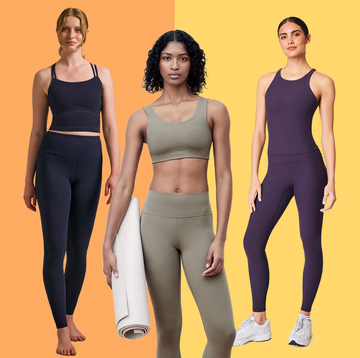I first became aware of glucose monitors a few years ago, when my diabetic friend showed me the white, circular device that, much to my surprise, was inserted into her arm (there’s a small sensor that sits directly under the skin). Back then, they were a rare sight and were just being rolled out to diabetics on the NHS. But fast forward to 2024 and everyone seems to be wearing one.
These tiny gadgets have been revolutionary for those with type 1 and type 2 diabetes, helping them better track and control their blood sugar levels. But now continuous glucose monitors (CGMs for short) have been made available to non-diabetic users by brands such as Lingo and Zoe. They’ve also been popularised by celebrities including Gabby Logan and Davina McCall. The big question, though, is are they really necessary for non-diabetics?
According to the brands behind them, they can provide a real-time picture of how your body responds to certain foods, helping you understand your metabolism better.
What to read next
So, to see if it’s a genuinely worthwhile investment for non-diabetics, I decided to wear a Lingo monitor for four weeks to see what the data told me.
I also worked closely with Pamela Nisevich Bede, Global Nutritionist at Abbott’s Lingo, to learn about how to use the stats, and understand the pros and cons of the device.
What are continuous glucose monitors (CGMs)?
CGMs are disposable sensors that you wear on your upper arm to track your blood sugar levels in real-time via an app on your smartphone. A tiny, needle-like sensor sits under the skin for continuous monitoring. You then get blood sugar readings on your phone and receive alerts if your glucose levels are too high or too low.
While this is extremely useful for diabetics, you may be asking yourself, ‘Why would I need this?’. I certainly was before I started the trial.
Well, maintaining a stable glucose level can have its benefits for everyone, from improved mood regulation and better quality sleep to increased focus, as well as helping to avoid sugar highs and crashes that can leave you craving more sugary foods and feeling sluggish. But more on that below.
How does Lingo work?
The set-up process was very easy. The box comes with an applicator, full instructions on how to insert the device, which lasts for two weeks, and how to link it to the Lingo app on your phone.
After inserting the Lingo biosensor into the back of my arm (which was quick and painless, by the way), I had to wait an hour for my first bit of data to come through (this is standard during set-up).
On the homepage, I was presented with my daily glucose number of 60. The more spikes you experience, the more points you accrue, so the goal is to make diet and exercise adjustments to curve that spike and remain under your daily target. Lingo says the glucose range that's considered ‘normal’ for metabolically healthy people is within the 3.9-7,9mmol/L (millimoles per litre).
Are there any concerns about glucose monitoring for non-diabetics?
First up, it's important to say that these monitors are expensive at £59 for a two-week plan (with one sensor) and £289 for a 12-week subscription (with six sensors).
The data it gives you can also be a little overwhelming if you’re not sure what it means or what to do with it. I found it really useful to have an expert on hand to help me interpret the numbers. If you’re looking to use a CGM, it’s worth speaking to your doctor or a nutritionist to help you analyse the results.
Experts have also warned that users can fixate on their blood sugar readings and become overly concerned with completely normal blood sugar fluctuations after eating, leading to disordered eating – or what some are calling “glucorexia”. The reality is that those spikes are normal and your body is able to process them efficiently.
However, others argue that seeing the impact of eating high sugar foods and the benefits of staying active in real time can encourage people to follow a more balanced lifestyle.
“Although the devices are designed for diabetics, CGMs can be used by anyone and have a range of benefits,” says Dr Donald Grant, GP and senior clinical advisor at The Independent Pharmacy. “Firstly, these devices allow people to closely monitor glucose levels and identify specific foods that cause those levels to spike. This can help pre-diabetics avoid any triggers, promoting a healthier lifestyle. These personalised insights can help people make better dietary choices, leading to weight loss and a lower risk of cardiovascular diseases.
“Additionally, a non-diabetic opting to wear a continuous glucose monitor can allow them to visualise the effect certain foods can have on stress levels and sleep. These monitors provide further clarity into how cortisol can affect blood glucose levels and how specific evening meals can impact sleep quality, allowing people to make lifestyle amendments,” he adds.
Who should be using a CGM?
The monitors were initially developed for diabetics to provide real-time feedback on blood sugar levels. Recently, they’ve made their way into the wider market for those who want to track their glucose levels for health and wellness purposes. From those with pre-diabetes to people wanting to understand their bodies and metabolism better, there are a whole host of different reasons you may want to track.
Ultimately, Bede says that Lingo is designed for those, “who want to fine-tune glucose levels, mitigate spikes and optimise their overall health, from mood to fatigue and sleep”.
“Glucose control can be beneficial for anyone,” she says. “I know for me, when I do a better job at staying centre and preventing spikes, then I avoid that huge crash after indulging in one thing or another,” she adds.
It sounds great, so I was interested to see how I got on during my month-long experiment. Here's my honest verdict.
My Lingo glucose monitor review
Tackling restless nights
As a sleepy girl who struggles to get enough quality Zs on a regular basis, I was particularly interested to see how tracking glucose levels could help my sleep and overall mood. Would I feel less tired throughout the day, and would I experience fewer energy dips?
I learnt from the app that consuming high-carb, high-sugar foods, such as my beloved chocolate bar treat, a couple of hours before sleeping, is likely to spike glucose levels and lead to a more restless night. So, I started to opt for a higher-carb lunch and filled up on more fibre at night. I didn’t forgo my after-dinner treat; instead, I went for a less sugary option. My go-tos during the experiment were Greek yoghurt and almonds or chopped apple with peanut butter.
I experienced spikes between three and four in the morning frequently, which I thought was unusual as there shouldn’t have been any triggers at those times. Bede informed me that this is known as the ‘dawn phenomenon’, which is essentially a release of hormones, including cortisol and growth hormones, that signal to the liver to produce glucose to help with waking up.
Though the dawn phenomenon is not necessarily a cause for concern, there are a few things I did to help mitigate it, such as going to sleep earlier – this is because a restful eight hours of sleep helps to reduce cortisol levels, which in turn minimises any spiking.
I made these simple changes – as well as incorporating what are now dubbed ‘fart walks’ (need I elaborate?) – after eating to use up some of the energy and plateau any prolonged or significant spikes. While I can’t say this was the sole reason for noticing an improvement in my quality of sleep, making these conscious choices did help me wind down at a reasonable hour and avoided disruptive 3am toilet trips.
Seeing stress spikes in real time
One of my biggest lessons during this experiment was how stress affects glucose control. The spiking I saw on the Lingo app perfectly aligned with when I was feeling overwhelmed. But, as insightful as it was to see the impact it had on my body physically, I wasn’t sure what to with this data practically. It felt about as useful as someone telling me to “calm down” in a moment of crisis.
It’s good to know, but it's not something I feel like I lack a massive amount of control over. When I pointed this out to Bede, she rightly said it’s not designed to be a stress-reduction tool, but instead is meant to nudge you towards managing the spike in other ways, such as taking a short walk, or doing some downward dogs, for example.
The hormone roller-coaster
Though I’m not menopausal myself, I am aware of some of the benefits reported by wearers going through it. Davina McCall, for instance, recently spoke about how wearing a CMG helped her better understand how her body reacts to food now, as it differs massively from her experience in her twenties and thirties.
Due to the decrease in key hormones such as oestrogen and progesterone during menopause, women are often more susceptible to insulin resistance. This is when the body doesn’t respond as well to insulin, which can lead to elevated blood sugar levels that can’t be absorbed by the muscles – this can heighten those already not-so-fun symptoms of menopause. In this instance, Lingo would be a great source of information to help track foods that trigger the spikes and avoid them. Exercise can also help to move sugar into the muscles.
It wasn’t something I noticed, but the GHI’s head of content, Alison Lynch, has type 1 diabetes, and she says she always notices more significant fluctuations in her blood sugar levels during her period. Some women can experience raised sugar levels around three to five days before their period starts. This is due, again, to the increased levels of progesterone in the body, which can cause insulin resistance. However, others find the opposite happens – sugar levels can fall a few days before, due to a rise in oestrogen levels. It seems to be different for everyone, which is where a monitor can help (and can be quite fascinating if you’re a bit geeky), allowing you to identify patterns and potentially tweak your diet and exercise to counteract any fluctuations.
Eating for energy
Another huge learning was the fact that all foods cause spikes, but it’s about how you can mitigate the larger spikes and avoid crashes, which manifest as low energy and fatigue. Think post-takeaway food-coma.
In the above screenshot, you can see my glucose levels spiking after I had my lunch at 1pm. They began to rise between 13:30 and 15:00, and added 7 to my daily Lingo count (which I was aiming to keep under 60).
These kinds of spikes will happen naturally anytime you eat carbohydrates and sugar. But when the sugar levels begin to fall once more, you can experience a crash and dreaded afternoon slump, which is what you can try to avoid by wearing a CGM. I learnt from using Lingo you can avoid this by adding more protein, fibre and fat into meals to slow down digestion, and avoid the sharp surges and crashes. You can also incorporate some movement to help bring it back down, which is what I now aim for after each meal. In the reading, you can see my levels return to stability after a post-lunch walk.
The Lingo app provided a lot of guidance around what you can change in your diet to help stabilise these highs and lows. I tried a few different methods, such as changing the order of what I eat first on my plate. The app recommends eating vegetables and protein ahead of carbohydrates as this can help keep a lower, more stable glucose rate. So, I tried eating my greens first, before cracking into my chicken and sweet potato.
Lo and behold, there was a difference in my reading – the previous evening, after the same dinner (when I went in blind, so to speak), my glucose went up to 10mmol/L. After reordering my plate, my levels went to 9.2mmol/L instead. Though it might seem a small difference, by incorporating this into all my meals, I hope to see the benefits in the long term.
Final verdict: Are CGMs worth it?
There are clear benefits to tracking glucose levels, and I think CGMs like Lingo can be a useful tool – especially for those who are pre-diabetic, menopausal, struggle with fatigue or are at the beginning of their health journey and could do with some extra knowledge and guidance. The app is a great resource for meal plans and tips, and I like the overarching message of eating healthily and incorporating movement into your routine.
It’s not for everyone, though. I think the tracking element could be unhelpful for those who struggle with disordered eating or tend to obsess over calorie counting. My regular porridge with blueberries was slightly tainted by the potential of spiking my glucose levels too much.
However, with further reading and research using the app, I found Lingo suggests adding a fat, such as peanut butter, to create a steadier glucose response, which does prove that it can be a helpful resource when used with the right mentality.
But I couldn’t help asking myself – do I really need to think so deeply about what’s on my plate, or is it better to just eat healthily and intuitively to the best of my ability?
I did learn some handy new tips and get some more inspiration for meal plans. For example, I now use soya milk instead of oat milk, as I learnt that oat sets off a more significant spike for me. I also try and pair higher sugar foods with a fat source (like peanut butter with apple) to try and stabilise my levels.
It’s not something I’ll be using in the long-term, but I can vouch for the benefits for someone who's looking to learn more about their metabolism and stabilise their blood sugar levels.
One of the things Pamela said that stood out to me most was, “Ask yourself how you feel after eating a certain food or completing exercise.” That’s ultimately what the Lingo sensor is trying to show users, giving them the data to help improve their overall wellbeing, mood and, hopefully, quality of life
To try it for yourself, you can purchase one biosensor with a two-week plan for £59, or a 12-week subscription that includes 6 biosensors for £289.
Madeleine is our Lifestyle Writer, specialising in expert-tested reviews and round-ups on the latest beauty Beauty and Health & Wellness products. From skincare to protein powders, Maddie is committed to providing honest and helpful reviews to help guide readers to the best product for them. Maddie has a BA in English Literature and Language, which stemmed from her lifelong interest in reading and writing. She started her post graduate life at Hearst UK within a marketing capacity, which quickly turned into a desire to fulfil a writing career.
When she is not writing about the latest expert reviewed products, you can find her rifling through vintage shops or car boots, reading a print magazine, or capturing portraits on her film camera.
















